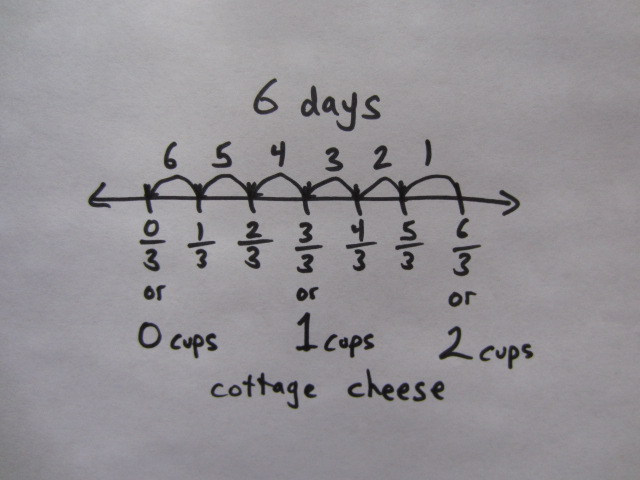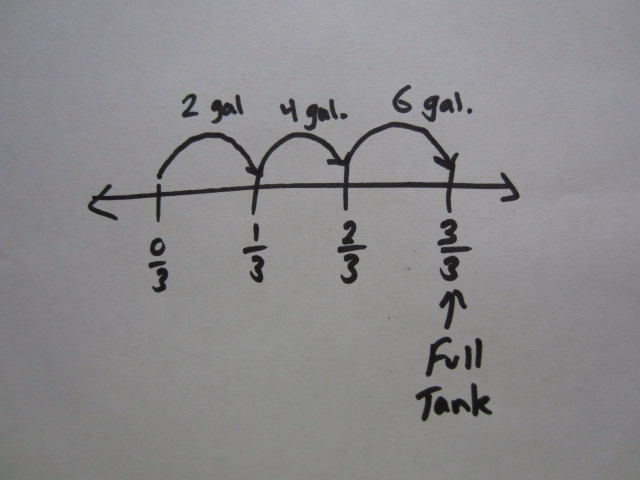Most teachers view the teaching of operations with fractions as challenging. Liping Ma refers to division of fractions as “a topic at the summit of arithemetic.” (1999, p. 55) Lately, I’ve been thinking about the multiplication and division portion of the 4th and 5th grade fraction domains in the Common Core State Standards for Mathematics (CCSSM). Specifically that the standards consistently call for the use of visual models. As a child and a pre-service teacher I wasn’t taught operations with fractions in this way. Because of this I’ve found myself having to work abstract to concrete in order to make sense of what it is students need to know. The funny thing is that the research says we should present learning opportunities that go in the opposite direction, progressing from the concrete to the abstract. In this post I’ll present a few problems that I’ve found in an article about dividing fractions, how I’ve been playing with them, and how they could be revised slightly to support the 5th grade CCSSM.
The first problem from the article:
I eat 2/3 cup of cottage cheese for lunch each day. I have 2 2/3 cups of cottage cheese in my refrigerator. How long will that last me? (Peck and Wood, 2008).
What I like about this problem is that it’s simple and a feasible real life context that surfaces division of fractions. Also, it’s a measurement division context, meaning that we know the groups size and are looking for the amount of groups. So, the problem can be thought of as repeated subtraction. The problem is that it doesn’t meet the 5th grade standard for dividing fractions (MACC.5.NF.2.7) because it’s dividing a mixed number by a fraction. The standard specifies dividing whole numbers by unit fractions and vice versa. So, it could be rewritten as:
I eat 1/3 cup of cottage cheese for lunch each day. I have 2 cups of cottage cheese in my refrigerator. How long will that last me?
Now, we’re good. This is a task that supports the 5th grade standard. Below are a few representations, including the use of manipulatives, that students could start with before moving on to the equation and trying to generalize a rule for dividing a whole number by a unit fraction. After making sense of the models below, it wouldn’t be a stretch for students to explain why 2 ÷ 1/3 can be solved by inverting the fraction and multiplying, then generalize the rule.
The problem above is a measurement context. What would a partitive problem look like? Let’s take a look at another problem from the article:
I put 2 2/3 gallons of gas into my empty lawn mower. I notice that it is now 2/3 filled. What is the capacity of my gas tank? (Peck and Wood, 2008)
Again, I like the problem, but it doesn’t meet the 5th grade standard. It could be rewritten as:
I put 2 gallons of gas into my empty lawn mower. I notice that it is now 1/3 filled. What is the capacity of my gas tank?
Now we have a partitive division problem that supports the 5th grade standard. I still may change the context to cups or ounces because 3 gallons seems like a lot for a lawn mower. Below are a few representations that students could use to solve the problem before explaining and generalizing the rule.
Hopefully this gives you a glimpse into how students can make sense of, explain, and generalize contexts in which they have to divide a whole number by a fraction. Who knows, maybe the new saying will go, “Yours is to reason why we invert and multiply!”
References
Ma, L. (1999). Knowing and teaching elementary mathematics: Teachers’ understanding of fundamental mathematics in China and the United States. New York: Dale Seymour Publications, Educational Development Center.
Peck, S. and Wood, J. (2008). Elastic, cottage cheese, and gasoline: Visualizing division of fractions. Mathematics Teaching in the Middle School. 14(4), 208-212.


